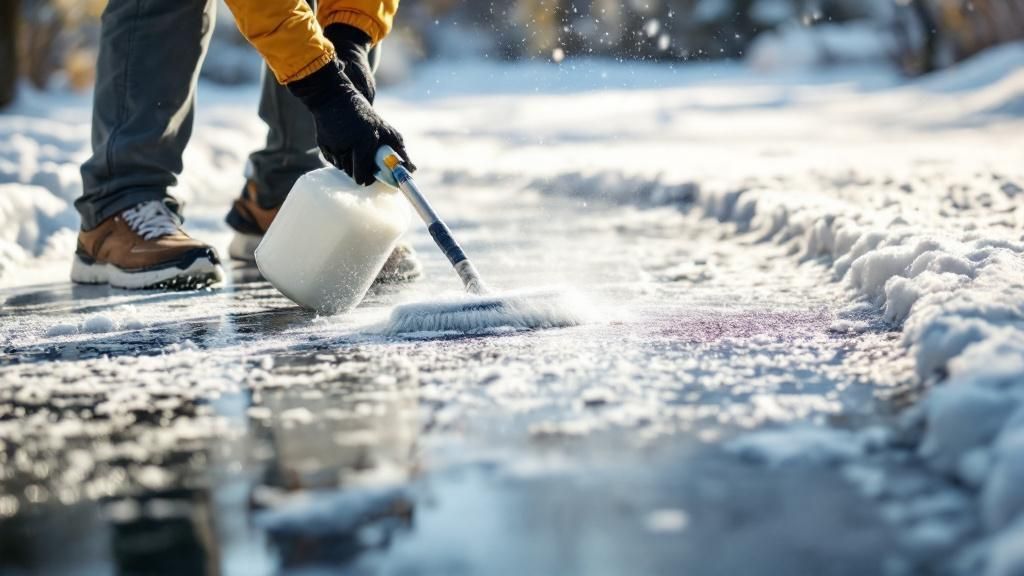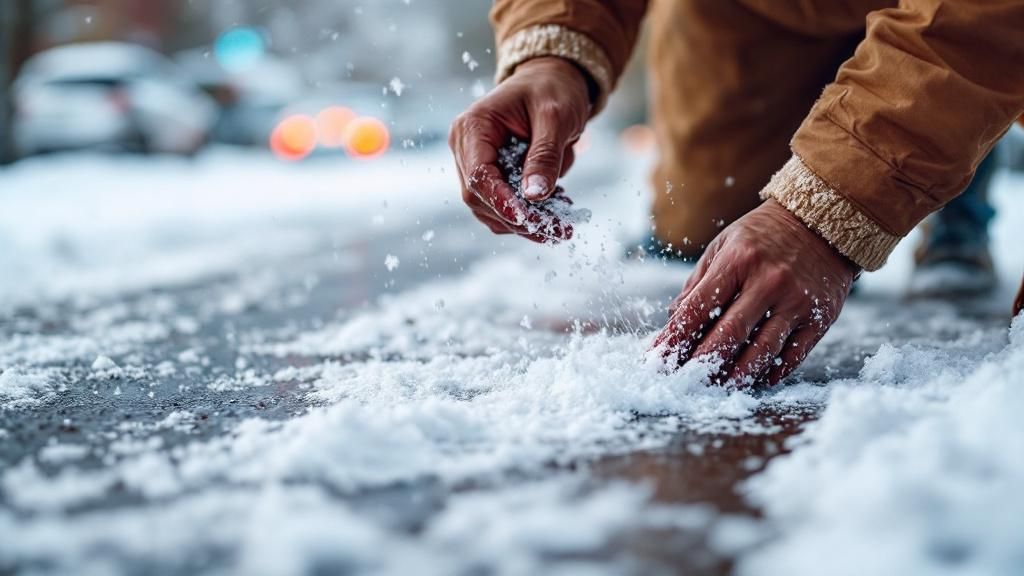
A Homeowner’s Guide to De-Icing Solutions in Anchorage
Key Takeaways
-
De-icing involves a range of materials, including salt, sand, and eco-conscious alternatives.
-
Salt is highly effective at melting ice but can damage soil, plants, and infrastructure.
-
Sand enhances traction but doesn’t melt ice; it’s often used alongside salt.
-
Eco-friendly solutions offer safer options for families and the environment.
-
Strategic use of de-icing products helps keep Anchorage homes and walkways safe during harsh winters.
Why De-Icing Is Essential in Anchorage
Living in Anchorage means dealing with prolonged snow and ice accumulation for several months each year. For homeowners, that makes de-icing an essential part of property maintenance. Whether you’re clearing your driveway, sidewalks, or backyard pathways, the goal is to reduce slip hazards and maintain accessibility—all while protecting nearby vegetation and structures.
Anchorage’s fluctuating winter temperatures and freeze-thaw cycles demand more than just occasional snow shoveling. Icy surfaces pose serious safety risks, and choosing the right de-icing method can make a big difference in effectiveness, cost, and environmental impact.
Common De-Icing Materials Used in Anchorage
Here’s a breakdown of the most common materials used in residential de-icing, along with their pros and cons:
Salt (Sodium Chloride)
Salt is the most widely used de-icer due to its affordability and effectiveness. It works by lowering the freezing point of water, which makes it easier to melt existing ice and prevent new layers from forming.
-
Pros: Affordable, easy to apply, fast-acting
-
Cons: Can harm plant life, corrode metal, and damage concrete
-
Note: Works best above 15°F. Below that, its effectiveness drops significantly.
Sand
Unlike salt, sand doesn’t melt ice. Instead, it improves traction, especially useful during active snowstorms when ice continues to build up.
-
Pros: Increases grip, inexpensive
-
Cons: Doesn’t remove ice, needs cleanup afterward
-
Use Case: Best used in tandem with salt for better safety on driveways and walkways
Magnesium Chloride
This alternative is gaining popularity for its effectiveness in lower temperatures and reduced toxicity. Magnesium chloride works at temperatures as low as -5°F and is less harmful to plants and pets.
-
Pros: More eco-friendly, less corrosive, effective in colder climates
-
Cons: Higher cost than salt
Calcium Magnesium Acetate (CMA)
Derived from limestone and acetic acid, CMA is biodegradable and less corrosive than traditional salts. It’s often chosen for residential areas with significant landscaping or close proximity to waterways.
-
Pros: Environmentally safe, non-corrosive
-
Cons: Less effective in extremely cold temperatures, expensive
Beet Juice and Brine Mixtures
Some eco-friendly products use agricultural byproducts like beet juice to reduce the freezing point of water when mixed with salt brine. These blends are often used to pre-treat surfaces and reduce the amount of salt needed.
-
Pros: Reduced environmental impact, effective pre-treatment
-
Cons: May be harder to find and more expensive
Strategic Application Matters
Using too much de-icer can harm plants, concrete, and nearby water systems. Applying too little renders the effort ineffective. Proper timing and technique matter just as much as material choice.
Tips for Homeowners:
-
Pre-treat before snowfalls: Applying a liquid de-icer before snow arrives helps prevent ice from bonding to surfaces.
-
Apply evenly: Scatter material using a hand spreader for even coverage.
-
Shovel first, then de-ice: Remove as much snow as possible before applying any product.
-
Avoid overuse: A thin, even layer is often more effective than dumping large piles of salt or sand.
Professionals who specialize in snow and ice management in Anchorage are trained in proper material handling and application methods. Some local providers also offer pre-treatment services ahead of storms, improving overall safety and reducing the need for excessive material use later.
Environmental Considerations
While keeping your home safe is the priority, it’s worth understanding the impact of different de-icing products:
-
Salt and chemical runoff can damage plants, soil structure, and nearby bodies of water.
-
Sand can clog storm drains if not cleaned up in spring.
-
Eco-friendly alternatives like CMA and beet juice blends break down more naturally and pose fewer risks to landscaping.
Anchorage residents who want to protect their property and the surrounding environment should consider incorporating more sustainable de-icing methods where possible. Simple swaps or adjustments in timing can make a big difference.
When to Call in the Pros
For larger properties, steep driveways, or high-traffic areas, hiring a professional snow and ice management team ensures safe, consistent results. These services often combine plowing with strategic de-icer application, saving homeowners both time and effort.
Titan specializes in residential snow removal and offers tailored de-icing plans that align with your property’s specific conditions—balancing safety, longevity, and environmental care.
Frequently Asked Questions
Is it okay to mix salt and sand?
Yes. This combo offers both ice melting (from salt) and traction (from sand), making it effective for slippery walkways and driveways.
Are eco-friendly de-icers safe for pets?
Many are. Products like magnesium chloride or CMA are generally safer than traditional salts, but always check the label.
How do I know which de-icer to use?
It depends on the surface, temperature, and whether you’re prioritizing cost, performance, or environmental safety.
What’s the best way to store de-icing products?
Keep them in a dry, sealed container and out of direct sunlight to prevent clumping and chemical breakdown.
Can de-icing products damage concrete?
Yes. Some salts can cause scaling or pitting in concrete over time. Opt for less corrosive products or seal your concrete surfaces for added protection.
If you want a safer, more manageable winter around your property, understanding how and when to use the right de-icing materials is key. Anchorage homeowners who work with experienced providers can count on smart application strategies, safe walkways, and lasting protection—without damaging their landscape or budget.
Titan, known for combining efficiency with eco-conscious techniques, continues to serve residents throughout Anchorage with residential snow and ice solutions tailored for Alaska’s conditions.
